International Maritime Associates
-
- U.S. NAVY SHIP MAINTENANCE AND MODERNIZATION Maritime Reporter, Jul 15, 1986 #8
Each quarter IMA prepares an update on developments in the Navy ship maintenance and modernization market. This article is an excerpt from the most recent update prepared exclusively for publication only in Maritime Reporter.
FY 1987 Budget Request The President's budget requests $6.4 billion for Navy ship maintenance and modernization. Details are provided in Exhibit 1.
Composition of FY 1987 Overhaul Program The Navy proposes to fund 37 ship overhauls in FY 1987, the same number as budgeted for this year.
The 37 overhauls include: • One aircraft carrier • Five ballistic missile submarines • Eight attack submarines • Fifteen surface combatants • Three amphibious ships • Four auxiliaries, and • One mine countermeasure ship In addition, 129 selected restricted availabilities and 48 phased maintenance availabilities are proposed for FY 1987. These are significant increases over current SRA/ PMA activity.
Work Split Seventeen of the 37 planned overhauls are currently earmarked for commercial shipyards. The remaining 20 overhauls are to be performed in naval yards.
The number of ship overhauls to be set aside for public/private shipyard competition will affect the final work split. No figure is currently available for the number of ships to be completed between commercial and naval shipyards in FY 1987.
However, a Navy directive in January specified that the five scheduled SSBN overhauls are to be competed next year.
Navy Reserve Fleet Maintenance The Navy plans to spend $153.5 million on reserve ship maintenance in FY 1987. This will fund four overhauls and 16 SRA/PMAs. These figures are provided in Exhibit 2.
MSC Ship Repair and Alteration Estimated FY 1986 spending by MSC for ship maintenance has been cut from $270 million to $203 million.
Only 22 overhauls are now planned this year. This is much lower than the 42 overhauls approved in the FY 1986 budget.
MSC has estimated that FY 1987 expenditures for ship maintenance and alterations will be $207 million.
This will fund-37 MSC ship overhauls.
The FY 1987 estimate is about the same as the current spending estimate for this year.
Until selected for the public/private competition, the FF-1050 and -1051 had been scheduled for Long Beach Naval Shipyard. The DDG- 42 had been assigned to the Charleston Naval Shipyard. Newport News and Charleston Naval Shipyard had originally been assigned one of the two SSBN overhauls.
Each of the other three surface ships had been scheduled for commercial bid. Probably the most critical competition involves the two frigates. Workload will be very low at Long Beach if these jobs are awarded to commercial yards.
Gramm-Rudman funding cuts may impact the surface ships earmarked for this compeition. They are among the few overhauls scheduled for FY 1986 not yet begun or awarded. These job starts may be the only candidates for deferral.
Ship Overhaul Buying-In In January, the GAO released a study (NSIAD-86-27) of contract cost growth in Navy ship overhauls.
The analysis was based on 105 regular ship overhauls completed between October 1982-May 1985.
For each overhaul GAO compared contract award amounts, government estimates and final prices.
GAO found that: • In the 75 fixed price contracts final cost exceeded award price by 63 percent • In the 30 cost reimbursement contracts final cost exceeded award price by 35 percent.
• 71 of the 75 fixed price contracts were awarded at prices below government estimates • 24 of the 30 cost reimbursement contracts were awarded at prices under government estimate • Modifications negotitated under fixed price contracts were made at prices higher than government cost estimates Exhibit 3 summarizes the cost growth found by GAO in each SUPSHIP office. As shown, cost increases have been particularly great in contracts administered by the San Diego SUPSHIP office.
Naval Shipyards Employment in the eight naval shipyards continues to fall. Total employment was 75,860 in June 1985. By the end of 1985 employment had fallen to 72,490. The Navy now projects that employment must decline to 68,000 during this fiscal year to meet budget objectives.
Meanwhile, NAVSEA has directed that overtime in the naval shipyards in FY 1986 be reduced by 3.2 million man-hours. A target of a 6.3 percent composite overtime rate has been set for this year, compared to 10.3 percent in FY 1985.
Small Business Set Asides The Navy has expressed concern to Congress about the impact of setting aside ship maintenance work for small businesses. Mr. Pyatt stated in late February that: One of the challenges we have in maintaining a national industrial base is proper utilization of both large and small businesses. During the past few years, we have properly relied on the capabilities of small business. Now, we find that small business preferences are operating to the disadvantage of the larger firms. The distribution of work is: Our policies need to, and indeed do, take into account a reasonable distribution of work between these two facets of the private sector.
This expression of concern is likely the forerunner of policy initiatives to reduce the number of jobs set aside for small businesses.
Homeport Policy Congress had considerable interest in the Navy's homeport during last year's appropriations process.
Several versions of homeport policy directives were voted through the House and Senate. In its final version Congress told the Navy to bid on a coastwide basis 25 percent of short term maintenance and repair work.
The Navy continues to oppose change in homeport policy—but there are indications that political pressures will be too great to ignore.
Strategic Homeporting The General Accounting Office has questioned the Navy's plan to develop additional homeports. In a March appearance before a congressional subcommittee, a GAO official stated: Our review leads us to an overall conclusion that the Navy needs to better demonstrate the strategic benefits of new homeports and to prepare more definitive and complete cost estimates as a basis for proceeding further.
Based on analysis of Navy cost data GAO found it would be "considerably less costly to accommodate the two carrier groups and three battleship groups in existing homeports than to establish new homeports for them." T O ORDER NAVY M A R K E T I N G REPORTS I n t e r n a t i o n a l M a r i t i m e Associates, Inc.
is a management consulting firm. It specializes in market research and corporate planning. Among its clients are electronics and machinery manufacturers, shipbuilders, and systems integrators.
IMA as part of its activities occasionally prepares a special analysis of high visibility markets. The f i rm has recently prepared in-depth analyses of U.S. Navy ship procurement and Navy ship maintenance and modernization: • U.S. Navy O v e r h a u l M a r k e t — 1 75 pages, updated through June 1986 • U.S. Navy Ship P r o c u r e m e n t — 2 15 pages, updated through May 1986.
These reports focus on market opportunities, c o n t r a c t i n g procedures and points of contact. They provide invaluable information for planning and implementing marketing efforts. Each report is updated every three months, ensuring the data remain current. The r e p o r t s— including four quarterly updates—are available to subscribers for $480 each f r om International Maritime Associates, 3050 K St NW, Washington, DC 20007 phone (202) 333-8501, telex 64325, telecopier 202 333 8504.
-
- U.S. NAVY SHIP PROCUREMENT Second Quarterly Update—November 1985 Maritime Reporter, Dec 1985 #70
This is an excerpt from the second quarterly update to the IMA report on U.S. Navy Ship Procurement. Information is current as of 8 November, except if noted. PROGRAM DEVELOPMENTS The number of Navy ships under contract continues to decline. Reports indicating significant future shipbuilding
-
- U.S. NAVY SHIP PROCUREMENT Maritime Reporter, Sep 1985 #30
— An Update — This article is an excerpt from the first quarterly update to International Maritime Associates' report on U.S. Navy Ship Procurement. It is divided into five sections: • legislative action • program developments • industry activity • projected market • revised Navy points of contact
-
- Navy Repair And Overhaul Market Maritime Reporter, Apr 1984 #36
for $480. This price includes the initial report plus four quarterly updates. The report can be obtained by writing: James R. McCaul, President, International Maritime Associates, Inc., 1800 K Street, N.W., Washington, D.C. 20006. A special pre-publication price of $380 is available to purchasers of
-
- The FPU Market Is Primed To Produce Maritime Reporter, Apr 2001 #33
According to a study just completed by IMA, 121 floating production systems are in operation or available. This is an increase of approximately 90 percent over the number of units in operation five years ago. About one-quarter of the units are operating off Northern Europe, another quarter off Brazil
-
- Future Requirements for Shuttle Tankers in the Gulf Maritime Reporter, Jun 2001 #42
Ultra-deepwater plays in the Gulf of Mexico offer vast potential for oil and gas production. There are now more than 1,650 active leases in the Gulf of Mexico in water depths exceeding 5,000 ft. and, with 24 drill rigs capable of drilling at this depth now working in the Gulf, activity on these
-
- Outlook for Floating Production Systems Maritime Reporter, Sep 2003 #52
orders will produce a capex value of $22 to 31 billion over the five year forecast period. About InternationaI Maritime Associates International Maritime Associates (/MA) was formed in 1973 to provide strategic planning support to clients in the offshore oil and gas, maritime and technology sectors
-
- Floating Production Systems to Grow 40% in Five Years Maritime Reporter, Apr 2013 #32
IMA has just completed an in-depth analysis of the floating production sector. The study profiles the deepwater industry, examines the dynamics driving the sector and forecasts orders for floating production systems between 2013 and 2017. Highlighted below are some key findings in the study. Growing
-
- Shale Oil Is it a Threat to Future Deepwater Development? Maritime Reporter, Sep 2013 #12
In general the floating production sector looks healthy and growth remains strong. But the sudden expansion of shale oil and tight oil production could disrupt the growth trajectory in the deepwater sector. Deepwater The underlying drivers for deepwater development point toward continued sector growth.
-
- Floating Production Systems: A Big Opportunity for Shipyards Maritime Reporter, Sep 2013 #62
Opportunities for Shipbuilders and Repair Yards In a Huge & Growing Market Since the beginning of this year, orders have been placed for 17 floating production systems. The combined value of the fabrication contracts exceeds $16 billion. By year end there will likely be another five to eight contracts
-
- Floating Production Systems: Market Update Maritime Reporter, Nov 2013 #54
Currently, 319 oil/gas floating production units are now in service, on order or being remarketed for reuse. FPSOs account for 66% of the existing systems, 73% of systems on order. Another 25 floating LNG processing systems are in service or on order. Liquefaction floaters account for 16%, regasification
-
- What’s New with Floating Production? Maritime Reporter, Dec 2013 #50
Currently, 319 oil/gas floating production units are now in service, on order or available for reuse on another field. FPSOs account for 65% of the existing systems, 75% of systems on order. Another 24 floating LNG processing systems are in service or on order. Liquefaction floaters account for 13%
-
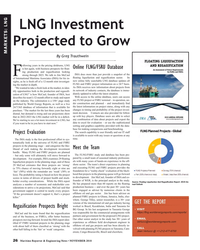 )
November 2018 - Maritime Reporter and Engineering News page: 26
)
November 2018 - Maritime Reporter and Engineering News page: 26just provide a snapshot of the strong through 2023. We talk to Jim McCaul F ? oating liquefaction and regasi? cation sector. Its of International Maritime Associates (IMA) for his in- new online fully searchable LNG database updates all sights, as he is fresh off of a 12-month stint investigat- FLNG
-
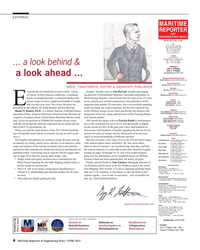 )
June 2015 - Maritime Reporter and Engineering News page: 6
)
June 2015 - Maritime Reporter and Engineering News page: 6, founder and manag- Web Contributor Michelle Howard [email protected] of reason’ in their business endeavors, a sounding ing director of International Maritime Associates and partner in board, an insight provider, a contrarian thinker that World Energy Reports. I have known Jim for each of my 22 years
-
 )
November 15, 1983 - Maritime Reporter and Engineering News page: 14
)
November 15, 1983 - Maritime Reporter and Engineering News page: 14San Francisco (SSN-711) Changes In The Navy Shipbuilding Program — An Update — Excerpted from a report published by International Maritime Associates, Inc. International Maritime Associates, Inc., is a management consulting firm located in Washington, DC. The firm specializes in
-
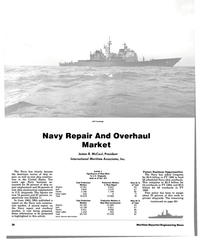 )
April 1984 - Maritime Reporter and Engineering News page: 34
)
April 1984 - Maritime Reporter and Engineering News page: 34USS Ticonderoga Navy Repair And Overhaul Market James R. McCaul, President International Maritime Associates, Inc. The Navy has clearly become the dominant source of ship re- pair, as well as new ship construc- tion in the United' States. Ten years ago Navy business ac- counted for 36
-
 )
August 15, 1984 - Maritime Reporter and Engineering News page: 62
)
August 15, 1984 - Maritime Reporter and Engineering News page: 62MASTER REPAIR AGREEMENTS WITH NAVY AND/OR MSC 17 PAGES Price Per Copy: $480.00 (including four updates) July 1984 Available From: International Maritime Associates, Inc. 1800 K Street, N.W. Washington, DC. 20006 (202) 296-4615 Telex: 64325 64 Circle 121 on Reader Service Card Maritime Reporter/Engin
-
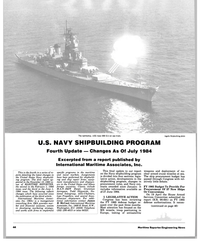 )
August 15, 1984 - Maritime Reporter and Engineering News page: 42
)
August 15, 1984 - Maritime Reporter and Engineering News page: 42Shipbuilding photo U.S. NAVY SHIPBUILDING PROGRAM Fourth Update — Changes As Of July 1984 Excerpted from a report published by International Maritime Associates, Inc. This is the fourth in a series of re- ports detailing the latest changes in the United States Navy shipbuild- ing program
-
 )
February 1986 - Maritime Reporter and Engineering News page: 28
)
February 1986 - Maritime Reporter and Engineering News page: 28as support ships. Navy will likely reduce operational tempo in an ef- fort to save money, with ships spending less time at sea. International Maritime Associates, Inc. is a management consult- ing firm. It specializes in market research and corporate planning. Among its clients are electronics
-
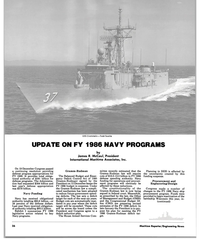 )
February 1986 - Maritime Reporter and Engineering News page: 24
)
February 1986 - Maritime Reporter and Engineering News page: 24USS Crommelin—Todd Seattle UPDATE ON FY 1986 NAVY PROGRAMS by James R. McCaul, President International Maritime Associates, Inc. On 19 December Congress passed a continuing resolution providing defense program appropriations for FY 1986. It provides total obliga- tional authority of $281
-
 )
March 1986 - Maritime Reporter and Engineering News page: 16
)
March 1986 - Maritime Reporter and Engineering News page: 16. Meanwhile, Navy plans for DDG construction over the next several years have been scaled down from five to three ships per year. International Maritime Associates, Inc. is a management consulting firm. It spe- cializes in market research and corpo- rate planning. Among its clients are elec- tronics
-
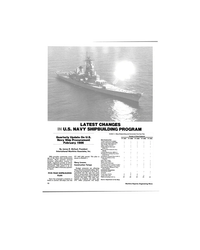 )
March 1986 - Maritime Reporter and Engineering News page: 10
)
March 1986 - Maritime Reporter and Engineering News page: 10CHANGES U.S. NAVY SHIPBUILDING PROGRAM Quarterly Update On U.S. Navy Ship Procurement February 1986 By James R. McCaul, President International Maritime Associates, Inc. Exhibit 1—Navy Shipbuilding and Conversion Five-Year Plan Jlumbei^^hig^udgete^ IMA provides continuing cover- age of the
-
 )
December 1987 - Maritime Reporter and Engineering News page: 41
)
December 1987 - Maritime Reporter and Engineering News page: 41THREE IMA BUSINESS REPORTS AVAILABLE International Maritime Associates, Inc. (IMA) special business reports will help keep you informed of developments in the marine business. More than 410 companies are among our subscribers. They include most of the major firms in the marine industry. Report No.
-
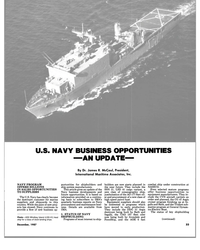 )
December 1987 - Maritime Reporter and Engineering News page: 25
)
December 1987 - Maritime Reporter and Engineering News page: 25U.S. NAVY BUSINESS OPPORTUNITIES —AN UPDATE— By Dr. James R. McCaul, President, International Maritime Associates, Inc. NAVY PROGRAM OFFERS BILLIONS IN SALES OPPORTUNITIES TO SUPPLIERS The U.S. Navy has clearly become the dominant customer for marine suppliers and shipyards in this
-
 )
March 1989 - Maritime Reporter and Engineering News page: 42
)
March 1989 - Maritime Reporter and Engineering News page: 42summarized in a format useful for competi- tive analysis. $480.00 for series of four quarterly reports To order please call or write: INTERNATIONAL MARITIME ASSOCIATES INC. 835 New Hampshire Ave., N.W. Washington, DC 20037 Telephone: (202) 333-8501 — Telex: 64325 IMA — Telefax: (202) 333-8504 IMH
-
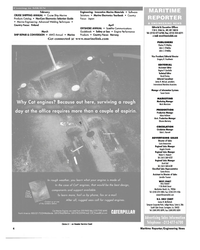 )
January 2000 - Maritime Reporter and Engineering News page: 4
)
January 2000 - Maritime Reporter and Engineering News page: 4Assistant Editor Regina P. (iardiello Technical Editor David Tinsley Editorial Consultant James R. McCaul, president, International Maritime Associates Manager of Information Systems Susan Cosme MARKETING Marketing Manager Mark Manziano PRODUCTION Production Manager Adam
-
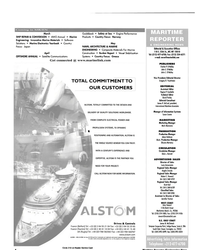 )
February 2000 - Maritime Reporter and Engineering News page: 4
)
February 2000 - Maritime Reporter and Engineering News page: 4Assistant Editor Regina P. Ciardiello Technical Editor David Tinsley Editorial Consultant James R. McCaul, president, International Maritime Associates Manager of Information Systems Susan Cosme MARKETING Marketing Manager Mark Monziano PRODUCTION Production Manager Adam
-
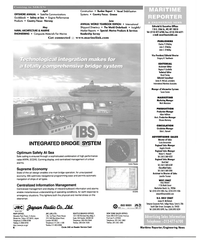 )
March 2000 - Maritime Reporter and Engineering News page: 4
)
March 2000 - Maritime Reporter and Engineering News page: 4Assistant Editor Regina P. Ciardiello Technical Editor David Tinsley Editorial Consultant James R. McCaul, president, International Maritime Associates Manager of Information Systems Susan Cosme MARKETING Marketing Manager Mark Manziano PRODUCTION Production Manager Adam
-
 )
April 2000 - Maritime Reporter and Engineering News page: 35
)
April 2000 - Maritime Reporter and Engineering News page: 35concern — real or perceived — which comes with offshore storage operations. According to a recent report from Washington, D.C.- based International Maritime Associates, there are cur- rently 107 floating production systems in operation worldwide, which is an increase of 67 percent over the total
-
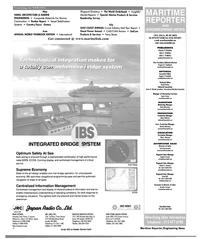 )
April 2000 - Maritime Reporter and Engineering News page: 4
)
April 2000 - Maritime Reporter and Engineering News page: 4Regina P. Ciardiello [email protected] Technical Editor David Tinsley Editorial Consultant James R. McCaul, president, International Maritime Associates Manager of Information Systems Susan Cosme [email protected] MARKETING Marketing Manager Mark Manziano manziano@morinelink
-
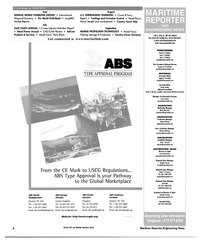 )
May 2000 - Maritime Reporter and Engineering News page: 4
)
May 2000 - Maritime Reporter and Engineering News page: 4Regina P. Ciardiello [email protected] Technical Editor Dovid Tinsley Editorial Consultant James R. McCaul, president, International Maritime Associates Manager of Information Systems Susan Cosme [email protected] MARKETING Marketing Manager Mark Manziano manziano@marinelink
-
 )
June 15, 2000 - Maritime Reporter and Engineering News page: 4
)
June 15, 2000 - Maritime Reporter and Engineering News page: 4Regina P. Ciardiello [email protected] Technical Editor David Tinsley Editorial Consultant James R. McCaul, president, International Maritime Associates Manager of Information Systems Susan Cosme cosme@marinelink. com MARKETING Marketing Manager Mark Manziano manziano@marinelink
-
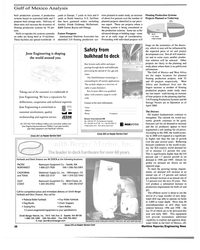 )
July 2000 - Maritime Reporter and Engineering News page: 38
)
July 2000 - Maritime Reporter and Engineering News page: 38U.S. facilities that have garnered orders including Amfels, Friede Goldman, McDermott, B&R Greens Bayou and Omega. Future Prospects International Maritime Associates has identified 210 floating production sys- tems planned or under study, an increase of about five percent over the number of planned
-
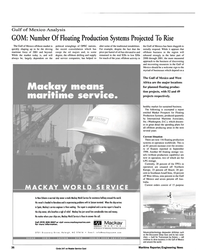 )
July 2000 - Maritime Reporter and Engineering News page: 36
)
July 2000 - Maritime Reporter and Engineering News page: 36business. The following is excerpted a report entitled Market Prospects for Floating Production Systems, produced quarterly by International Maritime Associates, Inc. (Washington, D.C.), which discuss- es in great detail the spending plans for all offshore producing areas in the next several
-
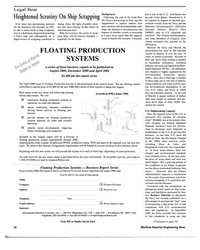 )
July 2000 - Maritime Reporter and Engineering News page: 16
)
July 2000 - Maritime Reporter and Engineering News page: 16Company: Address: • Pavment Enclosed • Please Invoice Telephone: E-mail Address: Signature: Fax: • Please send by e-mail International Maritime Associates, Inc. — 700 New Hampshire Ave., YVV— Suite 103 — Washington, DC 20037 USA Telephone: 202-333-8501 — Fax 202-333-8504 — E-mail:imaassoc@msn
-
 )
July 2000 - Maritime Reporter and Engineering News page: 4
)
July 2000 - Maritime Reporter and Engineering News page: 4Regina P. (iordiello [email protected] Technical Editor David Tinsley Editorial Consultant James R. McCaul, president, International Maritime Associates Manager of Information Systems Susan Cosme [email protected] MARKETING Marketing Assistant Angelica Rivera arivera@marinelink
